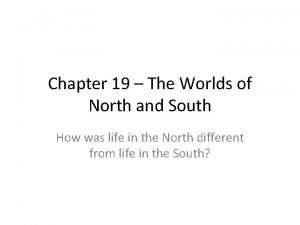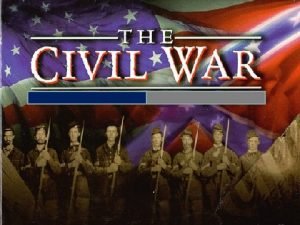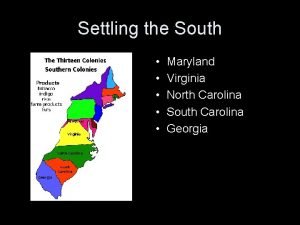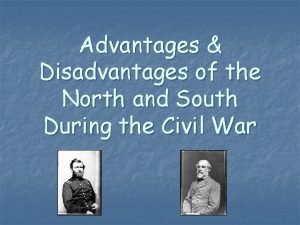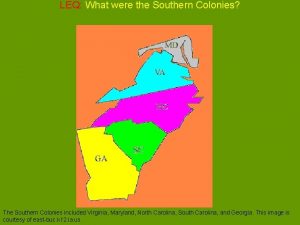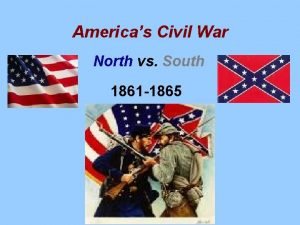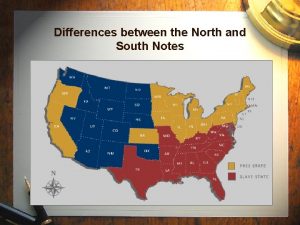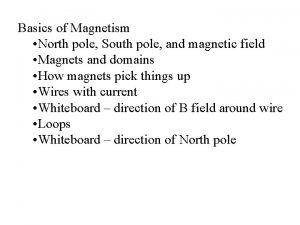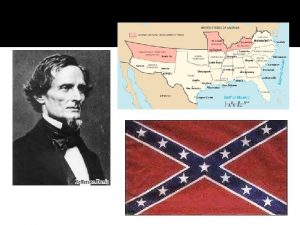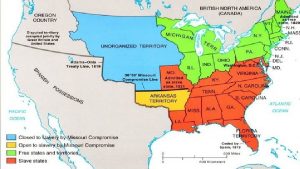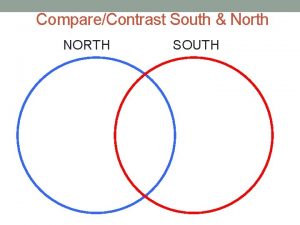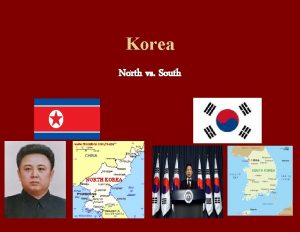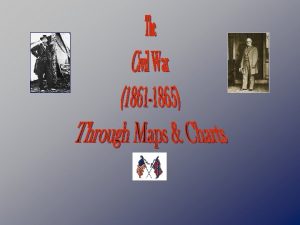The Worlds of North and South Introduction Eli




















- Slides: 20

The Worlds of North and South

Introduction – Eli Whitney A Problem The Idea Man • Complaints from planters/farmers: • Cotton grew well in the South • Eli Whitney The three areas differed in their economies, transportation systems, Using cheap slave labor, there was little profit inand raising societies – Cleaning the seeds out of cotton fibers was a big problem • A slave picking out seeds by hand could clean only a few pounds a day • – Invented a machine to: • Manufacture nails more quickly than making them by hand • Manufactured hat pins and men’s canes – While tutoring in the South • Came up with the idea of the Cotton Gin cotton – Will have different effects on the North and South

Geography of the North Features Northerners Natural adapted to • Jagged New England coast All the Northern states experienced four distinct geographical seasons Most northerly states differences • Inland from the sea by creating different industries and ways of making a living Climate • • – Had hundreds of bays and inlets -- perfect for use as harbors – Shipbuilding, fishing, and commerce flourished in this are – Had colder winters and shorter summer growing seasons than states farther south, such as Pennsylvania and Ohio. – Narrow, flat plain with a thin covering of rocky soil – Farming was not easy here • Instead, many people turned to trade and crafts – Others moved west in search of better farmland.

Geography of the North Natural Features • New England’s hills rose sharply above V-shaped valleys carved by steep streams • Farther south in New York, Pennsylvania, and New Jersey Negative Effect: Deforestation, • Central Plains, a large, forested drained by the Ohio or the clearingregion of forests and Mississippi rivers – New Englanders found that they could make money by harvesting timber • Wood was used for shipbuilding and in trade with other countries – Rivers deposited rich soil over the plains – Areas supported themselves by farming – Have some of the best agricultural soil in the world • Settlers cleared the forests to make way for farms

Geography of the South Climate Natural Features • Southern states enjoyed mild winters and long, hot, humid summers • Along the coast, the plains were dotted with swamps and marshes – Ideal for growing rice and sugarcane • Indigo was grown on the dry land above the swamps, and tobacco and corn were farmed farther inland Cities and towns all started by rivers – Plentiful rainfall and long growing seasons made this a perfect place for raising warm -weather crops • Above the plains rose the Appalachians – Carved farms and orchards out of rolling hills and mountain hollows – • • Most people in the South were farmers Southerners used natural resources in other ways as well Other Professions – Lumber – Gathered fish, oysters, and crabs

Economy of the South The Beginning • South’s economy was based on agriculture • Use of slaves had begun to decline (1790’s) – Most white Southerners were agrarians who favored a way of life based on farming • Rich plantation owners, did not have to do the hard work of growing crops themselves – Most white Southerners worked their own small farms • Plantation owners used slaves to grow such cash crops – – Tobacco Rice Sugarcane Indigo – Europeans were unwilling to pay high prices due to the decline • Cotton was a promising crop – Had a hard time making a profit • Had to find a time efficient way of sorting the seeds from the cotton – Discouraged planters were buying fewer slaves, and even letting some go free

Economy of the South The Beginning • Eli Whitney – Took a job tutoring children on a Georgia plantation • Observed the way cotton was cleaned by hand • Whitney had an idea – “If a machine could be invented which would clean the Cotton with expedition [speed], ” he wrote his father, “it would be a great thing. . . to the Country. ” • Six months later – Cotton Gin

Economy of the South The Impact of the Cotton Gin Expanding Demand for Land Slaves • Whitney’s “cotton engine, ” called the cotton gin for short • Raising cotton in the same fields year after year soon wore out the soil – Purpose: used rotating combs to separate cotton fiber from its seeds – Effect: a single worker could clean as much cotton as 50 laborers • Cotton was the South’s most important crop – Became the U. S. leading exported good – Result: went West for more soil – Whitney’s hopes: lighten the work of slaves • Instead, it made slavery more important to the South than ever – Slavery rose from 500, 000 to more than 3 million • Southerners putting money into land slaves, the South had little interest in building factories – Tredegar Iron Works in Richmond, Virginia • Made ammunition and weapons for the U. S. army, as well as steam engines, rails, and locomotives

Economy of the North Industrial Revolution • Began in England in the late 1700 s • Came to United States in the early 1800 s – A shift from making things and doing work by hand to making things and doing work with machines The Growth of Industry in the North • Francis Cabot Lowell – Saw how machines worked in England • Used fast-moving streams to turn a wheel = energy – Lowell memorized the design of the British machines • Built one of the first American textile factories, along the Merrimack River outside Boston – Factory combined spinning and weaving machinery in the same building

Economy of the North The Growth of Industry in the North • Workers – Hired young women, very eager to make money This era is known as the Steam Power • Technology hurt the work Industrial Revolution force • A. K. A: “Lowell Girls” – Worked 12 -15 hour days – Sundays off • The Growth of Industry in the North • New inventions and manufacturing methods made goods cheaper and more plentiful – Effect: Allowed for factories to be built anywhere – does not have to be along a river • Eli Whitney’s new concept – Interchangeable parts • Could assemble products even more cheaply by making them from identical parts – Concept: Build it faster, more quantity, charge less, make a profit – E. X. Elias Howe’s sewing machines • Machines could do more work and faster than seamstresses • Effect: people lost jobs

Economy of the North The Growth of Industry in the North • Factory owners – Tended to favor a strong national government • Promoted improvements in manufacturing, trade, and transportation • Southern Fears – Did not like the new wealth in the North – Big Fear: Northern interests might grow too powerful and threaten the South’s way of life

Economy of the North Machines Make Agriculture More Efficient • Cyrus Mc. Cormick Northern boomed • Industrial Revolutioneconomy Effects – New machines increased the rate at which agricultural goods could be produced – Built a machine called a reaper • 28 times faster at cutting grain than a single man using a scythe By 1860: Northern economy was 10 x’s • John Deere greater than the South – Built a reaper factory in Chicago, Illinois • Used the interchangeable parts idea – production boomed – Invented the steel-tipped plow • Reduced the amount of labor needed to plow a field • Made it easier to plant and harvest large quantities of wheat

Transportation in the North Building Better Roads • First attempt for improvement – 1806, Congress funded the construction of a National Road across the Appalachian Mountains – Purpose: • Connect the new western states with the East • Improvement stop – Monroe argued that spending federal money for a state’s internal improvements was unconstitutional (strict constructionist) Fast Ships and Canals • River travel was still faster and cheaper than travel by land – Going upstream was difficult • Steam engines would solve the problem • Robert Fulton (1807) – Raced the Clermont upstream on the Hudson River • Showed speed and efficacy for its time

Transportation in the North Fast Ships and Canals • Erie Canal • 1817, New York hired engineers and workers to build a 363 -mile canal from the Hudson River to Lake Erie • Because of its success – other states built canals • Clipper ships • Fast sailing ships – food would not spoil – Cut ocean travel time in half • Led to increased Northern trade with foreign ports around the world. Traveling by Rail • The future – Inspired by the success of steamboats • Advantages – Trains traveled faster than steamboats – Could go wherever tracks could be laid—even across mountains • Railroads were the North’s biggest business

Transportation in the South Rivers, and More Rivers • People and goods continued to move on rivers – Channels of Southern rivers made water travel easy and relatively cheap • Slave docks – Slaves loaded cotton bales directly onto steam-powered riverboats • Cotton boom made New Orleans one of the largest cities in the South – Once the cotton reached the sea • Loaded onto sailing ships headed for ports in England or the North • Towns and cities sprang up along waterways – Little need for roads or canals to connect these settlements • Southerners opposed bills in Congress that would use federal funds for internal improvements – Did not want to benefit the North • Some railroads were built in the South – Transported cotton to North • Half the rail lines of the North

Society in the South Social Classes Slavery Question • Top: Rich plantation owners • Middle: White farmers and workers • Bottom: African Americans —mostly enslaved • Situation – As long as the slave economy could be preserved • Little incentive to make progress economically or culturally • Religion was affected – South churches: preached it was ok to enslave • Opposite of the churches in the North – Separated North from South further

Society in the South White Southerners The Majority of Whites • Small group of wealthy plantation owners • Most white families – Controlled: • The economy and politics of the South • Enjoyed a leisurely way of life – Filled with parties and social visits • Education – Sons – went to Universities and colleges – Daughters – raised to be wives and hostesses – Owned some land • Only about one in four owned even one slave • The majority worked their own fields – Made most of what they needed themselves • 10 percent of whites were too poor to own any land – They rented rugged mountain or forest land paid the rent with the crops they raised • Many white children were illiterate

Society in the South African Americans in the South • Small minority of the African • Majority of African Americans were free blacks Americans in the South were slaves • Had to do the following: – Wear special badges – Pay extra taxes – Live separately from whites • Occupations: – Craftspeople, servants, or laborers – Worked as: • Cooks, carpenters, blacksmiths, house servants, or nursemaids – Majority were: • Field hands who labored from dawn until past dusk

Society in the North Urban Sprawl • Cities are growing rapidly – People still live on farms (7 out of 10 people) • Big cities like New York, Philadelphia, and Boston are growing rapidly – Jobs are there • Cities of the North – Unsanitary • No sewers or paved streets • Disease spread rapidly African Americans in the North • Blacks in the North were free, they were not treated as equal to whites • Limitations: – – Could not vote Hold office Serve on juries Attend white churches and schools • African Americans often worked as laborers or servants – Due to employers would not hire them

Society in the North Immigrants Arrive in the North • Between 1845 and 1860, four million immigrants came to the United States • Resentment – From Ireland Germany • People of Ireland left due to a potato famine • Germans left due to failed revolutions – Many lived in the cities where jobs were offered – Americans resented the Irish the most • They were Roman Catholic – The United States was mostly Protestant at the time • Accepted very low wages – This took jobs away from native-born workers – More than one-third of all U. S. immigrants came from Ireland
 Lesson 19 the worlds of north and south answer key
Lesson 19 the worlds of north and south answer key Eli eli lama azavtani analiza pjesme
Eli eli lama azavtani analiza pjesme Lesson quiz 14-1 north and south
Lesson quiz 14-1 north and south Slides
Slides Anaconda plan
Anaconda plan Imaginary lines of the earth
Imaginary lines of the earth Maryland, virginia, north carolina, south carolina, georgia
Maryland, virginia, north carolina, south carolina, georgia Advantages and disadvantages of the north and south
Advantages and disadvantages of the north and south North and south strengths and weaknesses chart
North and south strengths and weaknesses chart Swana region
Swana region Angular distance latitude longitude
Angular distance latitude longitude North and south states civil war
North and south states civil war Map of north carolina and south carolina
Map of north carolina and south carolina North and south states civil war
North and south states civil war North america south america europe asia
North america south america europe asia North and south notes
North and south notes North central south america
North central south america Define north pole and south pole
Define north pole and south pole Chapter 20 girding for war the north and the south
Chapter 20 girding for war the north and the south Integrated care system north east
Integrated care system north east Old south vs new south streetcar named desire
Old south vs new south streetcar named desire
